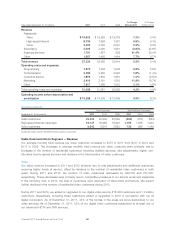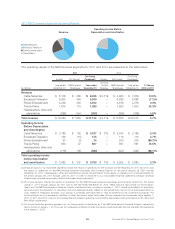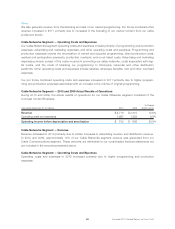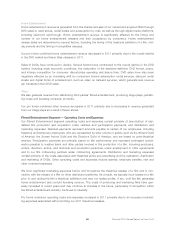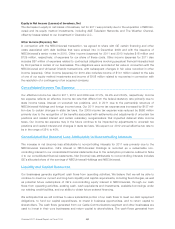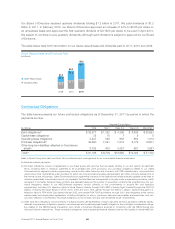Comcast 2011 Annual Report Download - page 61
Download and view the complete annual report
Please find page 61 of the 2011 Comcast annual report below. You can navigate through the pages in the report by either clicking on the pages listed below, or by using the keyword search tool below to find specific information within the annual report.Home Entertainment
Home entertainment revenue is generated from the license and sale of our owned and acquired films through
DVD sales to retail stores, rental kiosks and subscription by mail, as well as through digital media platforms,
including electronic sell-through. Home entertainment revenue is significantly affected by the timing and
number of our home entertainment releases and their acceptance by consumers. Home entertainment
release dates are determined by several factors, including the timing of the theatrical exhibition of a film, holi-
day periods and the timing of competitive releases.
Our pro forma combined home entertainment revenue decreased in 2011 primarily due to the overall decline
in the DVD market and fewer titles released in 2011.
Sales of DVDs have continued to decline. Several factors have contributed to the overall decline in the DVD
market, including weak economic conditions, the maturation of the standard-definition DVD format, piracy,
and intense competition for consumer discretionary spending and leisure time. DVD sales have also been
negatively affected by an increasing shift by consumers toward subscription rental services, discount rental
kiosks and digital forms of entertainment, such as video on demand services, which generate less revenue
per transaction than DVD sales.
Other
We also generate revenue from distributing third parties’ filmed entertainment, producing stage plays, publish-
ing music and licensing consumer products.
Our pro forma combined other revenue decreased in 2011 primarily due to decreases in revenue generated
from our stage plays as a result of fewer shows.
Filmed Entertainment Segment — Operating Costs and Expenses
Our Filmed Entertainment segment operating costs and expenses consist primarily of amortization of cap-
italized film production and acquisition costs, residual and participation payments, and distribution and
marketing expenses. Residual payments represent amounts payable to certain of our employees, including
freelance and temporary employees, who are represented by labor unions or guilds, such as the Writers Guild
of America, the Screen Actors Guild and the Directors Guild of America, and are based on post-theatrical
revenue. Participation payments are primarily based on film performance and represent contingent consid-
eration payable to creative talent and other parties involved in the production of a film, including producers,
writers, directors, actors, and technical and production personnel, under employment or other agreements
and to our film cofinancing partners under cofinancing agreements. Distribution and marketing expenses
consist primarily of the costs associated with theatrical prints and advertising and the replication, distribution
and marketing of DVDs. Other operating costs and expenses include salaries, employee benefits, rent and
other overhead expenses.
We incur significant marketing expenses before and throughout the theatrical release of a film and in con-
nection with the release of a film on other distribution platforms. As a result, we typically incur losses on a film
prior to and during the film’s theatrical exhibition and may not realize profits, if any, until the film generates
home entertainment and content licensing revenue. The costs of producing and marketing films have gen-
erally increased in recent years and may continue to increase in the future, particularly if competition within
the filmed entertainment industry continues to intensify.
Pro forma combined operating costs and expenses increased in 2011 primarily due to an increase in market-
ing expenses associated with promoting our 2011 theatrical releases.
59 Comcast 2011 Annual Report on Form 10-K



